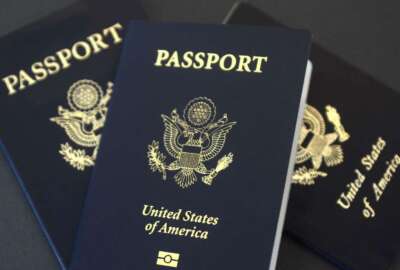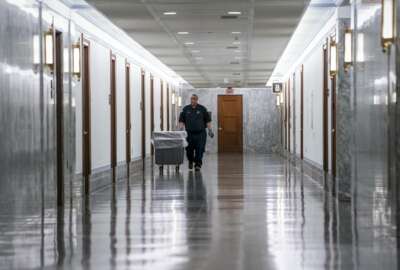
OPM offers up its own take on reopening its facilities
Masks aren't required at Office of Personnel Management facilities, and employees with limited transportation or dependent care options will be "encouraged" to...
The federal government’s human resources agency has released its own guide for reopening its offices and facilities.
The Office of Personnel Management is the latest agency to publicly release a plan for reopening its own facilities to employees and the public. Several other agencies have released similar guides or reopening summaries to their employees in recent weeks.
Like the plans from other organizations, OPM’s reopening guide is consistent with the three broad phases the Trump administration outlined for agencies back in April.
“The guide provides a framework that is intended to support OPM supervisors with guidelines and planning considerations for how to evaluate the needs of employees as OPM returns from a max telework operating status,” the plan reads. “With over 20 individual properties whose occupancy ranges from two to over 1,200 people, there is no one-size-fits-all solution.”
Senior leaders from each OPM facility will serve as local points of contact and will sit on an agency reopening task force to inform the acting director, who make decisions as necessary.
OPM will give at least one week’s notice to employees about the scheduled reopening date for a particular facility, the agency said.
Under phase one, OPM managers should “continue to encourage telework,” according to the reopening plan. Specifically, the agency should encourage telework for employees whose public transportation or parking arrangements are disrupted, or whose child care, school or dependent care options are limited due to the pandemic.
OPM supervisors “may require individuals to return to OPM workspaces if it is necessary to perform essential duties,” according to the reopening plan.
They should also strongly consider special accommodations for OPM employees who are considered at high risk for coronavirus. Alternative service schedules or work arrangements may be an option as well, OPM said.
Masks aren’t required at OPM facilities, although the agency will ensure it has enough masks and gloves for security staff, staff who interact with the public and employees who handle the mail, provide building services or process personal identity verification (PIV) cards, according to the reopening plan.
Common areas will be closed, and “to-go” food services will be in place at OPM facilities during phase one. High-touch areas at OPM buildings will be cleaned with more frequency, and facilities staff will ensure the agency has enough cleaning supplies on hand.
OPM facilities staff will review agency workspaces and will install hand sanitizer stations and cleaning stations near copiers, printers and other shared office equipment.
“Open workspaces that do not allow at least six feet between employees may require that employees work onsite in shifts (telework/onsite), if possible, to allow for social distancing, or may require other mitigation strategies,” the reopening plan reads. “Walk-up services will require the installation of sneeze shields and/or other appropriate safety barriers. Safety barriers will also be evaluated for use in the reception area of office suites.”
In addition, signs will be placed around OPM buildings to encourage social distancing and remind employees to report coronavirus symptoms.
Little seems to change under phase two of OPM’s reopening plan. Managers will continue to “encourage” telework for employees, particularly for those who have children at home or whose commute options are limited.
Managers will “require individuals to return to OPM workspaces if it is necessary to perform essential duties and/or if work is better performed if executed in OPM workspaces,” according to the reopening plan.
Common areas will stay closed and most meetings will remain virtual. The same cleaning and mask procedures from phase one will continue in phase two.
Facilities staff will examine cubicle spaces under phase two. Those with high walls won’t need new arrangements, but cubes located near shared office equipment may require some modifications, OPM said.
Under phase three, OPM will resume “unrestricted staffing” at its facilities, though the agency will continue to review employee requests for telework accommodations on a case-by-case basis. “High risk” employees can resume public interactions but should avoid crowded spaces, the OPM plan said.
OPM facilities may revert back to prior phases depending on local conditions, the reopening plan acknowledged.
In addition, the plan includes “considerations for operating site preparedness,” which shed more light on the agency’s thought process for reopening. OPM sites are deemed to be prepared for full reentry, for example, when local transit lines and parking services that support the agency are operational.
OPM’s latest reopening plan came as a group of federal employee unions on Monday wrote directly to President Donald Trump, seeking assurances that agencies wouldn’t rush to bring workers back to their offices before taking certain safety measures.
The Federal Workers Alliance, a coalition of unions representing some 300,000 government employees, urged the president to adopt 11 precautions to ensure workforce safety at federal agencies.
The unions, which include the National Federation of Federal Employees and the American Federation of State, County and Municipal Employees, want agencies to provide on-demand coronavirus testing for employees who suspect they’ve been exposed.
They’re also looking for administrative leave and telework flexibilities for employees who believe they’ve been exposed, and they’re seeking assurances that workers won’t be unnecessarily pressured into coming to the office.
“The safety of federal workers directly impacts the safety of all Americans,” the unions wrote. “We share in your desire to resume the vital work of federal employees as soon as it can be responsibly achieved, and we hope you recognize that it is paramount that workers be protected while performing their duties. We must insist that you take these reasonable actions to ensure their safety. Anything less will put hundreds of thousands of dedicated federal employees, their families and the Americans they serve, in unnecessary danger.”
Copyright © 2025 Federal News Network. All rights reserved. This website is not intended for users located within the European Economic Area.
Nicole Ogrysko is a reporter for Federal News Network focusing on the federal workforce and federal pay and benefits.
Follow @nogryskoWFED





